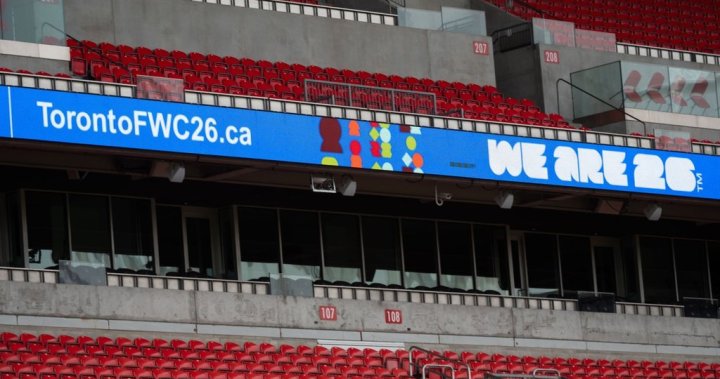Uncategorized
Countdown clocks mark 1 year until World Cup soccer fans descend on Toronto, Vancouver

The one-year countdown to the 2026 World Cup starts Wednesday, with clocks to be unveiled to mark the occasion in Toronto, Vancouver and Niagara Falls.
Toronto and Vancouver are World Cup host cities. Niagara Falls offers a world-class backdrop for a reminder that FIFA’s expanded 48-team soccer showcase is just around the corner.
There are more milestones to come in Canada, with a call for some 7,000 volunteers to be issued in August, ticket sales starting in September and the tournament draw in December.
Adidas has yet to unveil the match ball. Tournament mascots will also be introduced. The tournament’s official poster will join those of the 16 host cities.
And the World Cup trophy is scheduled to make an appearance in Ottawa on Canada Day.
The World Cup kicks off June 11, 2026, with games in Mexico City and Guadalajara. On June 12, the focus switches to matches in Toronto and Los Angeles.
The final is set for July 19 at MetLife Stadium in East Rutherford, N.J.
“It’s nine years so far on this project,” said Peter Montopoli, chief tournament officer for Canada. “This marathon is now at one year out, turned into a sprint. I think that’s the part we really enjoy. For the people who love to run events, this is the part that really excites them. This is where all the magic happens in the last year.
“So it’s exciting. It’s an exciting time to be running the event, it’s an exciting time for FIFA and it’s an exciting time for our country.”
In all, there will be 104 games, with 13 each in Canada and Mexico and the remaining 78 in the U.S. The last seven editions of the tournament featured 32 teams and 64 games.

Get breaking National news
For news impacting Canada and around the world, sign up for breaking news alerts delivered directly to you when they happen.
In addition to co-hosts Canada, Mexico and the U.S., Japan, Iran, Japan, Jordan, South Korea and Uzbekistan have already qualified from Asia, along with New Zealand from Oceania and defending champion Argentina from South America (CONMEBOL).
It will be a first World Cup appearance for both Jordan and Uzbekistan.
On Wednesday, the two Canadian host cities will also release anniversary videos with actor Will Arnett featured in Toronto’s and former Canada goalkeeper Karina LeBlanc in Vancouver’s.
Canadians will be able to apply for tickets two ways — through the FIFA lottery (assuming FIFA follows past practices) and via membership in Canada Soccer’s Canada Red program, which will distribute the ticket allotment for Canada matches.
“There’s different ways to purchase (tickets),” said Montopoli. “If you want to get in early, you go in the fall.”
Montopoli said there is no word yet on ticket pricing.
While the full match schedule won’t be known until the draw, Canada will open in Toronto and then play its remaining group games in Vancouver. Toronto and Vancouver will each host five opening-round matches plus a round-of-32 knockout match. Vancouver will also stage a round-of-16 game.
Canada Soccer is revamping its existing Canada Red membership program, expanding it from the current three tiers (the first free and the other two at a cost of $50 and $150 annually) to seven levels (from free to $5,000 annually). Each tier provides access to Canada Soccer’s ticketing allotment lottery for games featuring the Canadian men — the higher the tier, the higher the chances of securing tickets.
FIFA traditionally reserves a portion of each World Cup game’s tickets for the participating member federations. This is Canada Soccer’s method of distributing them. Canada Soccer also used a Canada Red tiered approach for tickets for Canada’s games at the 2022 World Cup in Qatar.
Canada Red members in the top tiers will have the best chance to access tickets as they will have access to the first draw and each subsequent draw afterwards.
Canada Red, the new version of which launches later this summer, “directly supports” Canada Soccer’s philanthropic initiatives, according to Canada Soccer.
The Canada Red program currently has more than 100,000 members.
While the clock counts down, the City of Toronto is still looking for funds to help pay for its end of the tournament, arguing that it is having to dig deeper into its pocket because the cost of providing services related to public transport, policing and hospitals, among others, has increased to almost $40 million in total — reducing the provincial cash contribution and adding to the city’s bill.
The cost of hosting six games in Toronto has been pegged at $380 million, with the federal government contributing $104 million and Ontario, including services, $97 million. Toronto’s tab is $178.7 million (47 per cent of the total cost).
A ring of permanent suites is under construction at B.C. Place Stadium. BMO Field will get an additional 17,750 seats, bringing total capacity to around 45,735 seats, with the north and south ends expanded.
Two of four new video screens are now working at BMO Field, which is also getting new suites.
FIFA will take over the tournament stadiums 30 days before the first game there, which would mean May 13 for Toronto and May 14 for Vancouver.
The tournament office in Toronto, already up and running, will have 82 full-time staff — it’s currently around 70 — with most getting an early taste of tournament work via the FIFA Club World Cup, which kicks off later this month in the U.S. The Vancouver office opens next Tuesday ahead of the CONCACAF Gold Cup.
“We know what we need to do to execute,” Montopoli said of tournament preparation. “So we feel very comfortable in where we stand today. There’s always little nuances that can happen, but as of today — one year out — we’re exactly where we felt we needed to be to position ourselves for success.”
© 2025 The Canadian Press
Uncategorized
Blue Jays reinstate Gimenez from injured list

TORONTO – The Toronto Blue Jays reinstated second baseman Andres Gimenez from the 10-day injured list Tuesday and designated infielder Buddy Kennedy for assignment.
Gimenez, a three-time Gold Glove award winner, missed five weeks with a left ankle sprain.
Related Videos
The moves were announced shortly before the Blue Jays opened a three-game series against the visiting Chicago Cubs.
Entering play Tuesday night, Gimenez had five homers, 23 RBIs and a .218 average.

Get daily National news
Get the day’s top news, political, economic, and current affairs headlines, delivered to your inbox once a day.
Kennedy had one hit in two games for the Blue Jays. He also played four games for the Philadelphia Phillies earlier this season.
This report by The Canadian Press was first published Aug. 12, 2025.
© 2025 The Canadian Press
Uncategorized
Man dead, another in custody after stabbing in Toronto’s east end


Around 2:30 p.m., Toronto police said they were called to the area of Woodbine and Duvernet avenues for reports someone had been stabbed inside a neighbouring home.
Source link
Uncategorized
Jays’ Shapiro says he wants to remain with team

TORONTO – Blue Jays president Mark Shapiro declined to comment on contract extension talks Tuesday but said he wants to remain with the club and that team ownership has been “reciprocal in that desire.”
Shapiro, who also serves as chief executive officer, is in the final year of his contract.
“When I think about alternatives, I’ve never been a grass is greener guy,” he said in a pre-game availability. “Twenty-four years in one place in Cleveland and 10 years here now.
Related Videos
“So it’s the appreciation for what I have and the people that I get to work with every day, the city that I work in and the country that I live in, those things are drivers for me to remain here.”
Shapiro, 58, joined the club in 2015 and signed a five-year extension in January 2021.

Get daily National news
Get the day’s top news, political, economic, and current affairs headlines, delivered to your inbox once a day.
He took questions from reporters for about 20 minutes in a rare in-season media session. Shapiro was asked directly whether there had been discussions with team owner Rogers Communications on a new deal.
“Sure, yeah, I mean I think (it’s) not appropriate for me to comment beyond the fact that what I just said is I want to remain here,” Shapiro said. “And I can also say that both (Rogers executive chair) Edward (Rogers) and (Rogers president/CEO) Tony (Staffieri) have been reciprocal in that desire.”
It has been a worst-to-first campaign for Canada’s lone Major League Baseball team. The Blue Jays finished last in the American League East division standings last season but have enjoyed a stellar season in 2025.
Toronto entered Tuesday night’s game against the visiting Chicago Cubs with the best record in the AL at 69-50.
This report by The Canadian Press was first published Aug. 12, 2025.
© 2025 The Canadian Press
-

 Uncategorized2 months ago
Uncategorized2 months agoAccording to Dior Couture, this taboo fashion accessory is back
-

 Uncategorized2 months ago
Uncategorized2 months agoThese ’90s fashion trends are making a comeback in 2017
-

 Uncategorized2 months ago
Uncategorized2 months agoThe old and New Edition cast comes together to perform
-

 Uncategorized2 months ago
Uncategorized2 months agoUber and Lyft are finally available in all of New York State
-

 Uncategorized2 months ago
Uncategorized2 months agoNew Season 8 Walking Dead trailer flashes forward in time
-

 Uncategorized2 months ago
Uncategorized2 months agoMeet Superman’s grandfather in new trailer for Krypton
-

 Uncategorized2 months ago
Uncategorized2 months ago6 Stunning new co-working spaces around the globe
-

 Uncategorized2 months ago
Uncategorized2 months agoThe final 6 ‘Game of Thrones’ episodes might feel like a full season







